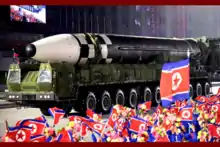Hwasong-16
The Hwasong-16 (Korean: 화성 16호; Hanja: 火星 16号), or KN-27 under U.S. intelligence designations,[4] is a new missile unveiled by North Korea on October 10, 2020, the 75th anniversary of the founding of the Workers' Party of Korea parade.[5] This missile is seen as a new iteration of the Hwasong-15 and is another step along the path of North Korea's intercontinental ballistic missile (ICBM) program.
| Hwasong-16 | |
|---|---|
 Hwasong 16 at the 75th WPK anniversary parade. | |
| Type | Intercontinental ballistic missile |
| Place of origin | |
| Service history | |
| In service | 2020 - Present |
| Used by | North Korea |
| Production history | |
| Produced | 2020 - present |
| Specifications | |
| Mass | ≈80,000–150,000 kilograms (180,000–330,000 lb)[1][2] |
| Length | ≈24–26 m (79–85 ft)[1][2] |
| Diameter | ≈2.4–2.9 metres (7.9–9.5 ft)[1][2] |
| Warhead | nuclear weapon, possibly MRV |
| Warhead weight | ≈2,000–3,500 kg (4,400–7,700 lb)[1][2] |
| Engine | 4 RD-250-type rocket engines (first stage)[1] |
Operational range | 13,000 km (8,100 mi) (notional)[3] |
Launch platform | 11-axle Transporter erector launcher (TEL) |
Description

The Hwasong-16 is assumed to be a two-stage, liquid fuelled road-mobile ICBM carried by a 22-wheeled vehicle. The missile itself is judged from images to be 26 m long with a diameter of 2.7 m. The exact capabilities of the missile are as yet unconfirmed, though speculation by experts has fueled questions as to whether it could reach cities within the United States and potentially evade U.S. missile defenses too.[6] It also might have the capability of carrying multiple re-entry vehicles (MRVs),[1][7] which would be a less expensive way to launch multiple warheads than deploying many ICBMs with single warhead payloads. The size and configuration of the 11-axle TEL indicates North Korea has developed a domestic capacity to manufacture such vehicles, a matter of concern to observers as attempting to block procurement of foreign-built TELs was one limitation on the nation's ICBM force. The country being able to produce their own launchers lifts that constraint and enables them to have the capacity to fire greater numbers of missiles.[8][4]
Since the Hwasong-15 was already capable of striking most of the contiguous United States, the development of an even larger missile suggests North Korea is pursuing MRV, or even MIRV, payloads. As of 2020, the Ground-Based Midcourse Defense system comprises 44 interceptors, requiring the launch of at least four to guarantee a hit, enabling it to protect against a maximum of 11 warheads. The Hawsong-16 may contain three or four warheads, or potentially a mix of decoys and real warheads, so the launch of just a few missiles would be enough to overwhelm U.S. defenses.[9][4] Despite posing such a threat, the missile is greatly limited by its sheer size. The combined weight of the missile and its TEL restricts movement to North Korea's limited network of paved roads, as it would only be able to travel short distances on unpaved roads and only on sturdy ground. Unlike smaller liquid-fueled ballistic missiles, it is unlikely that it can be fueled at a secure location and then driven to and erected at a pre-surveyed site to cut down on launch preparation time, as vibrations during movement of such a large missile would risk causing damage and leaking volatile fuel. This restricts fueling to once it arrives at the launch site itself, a process requiring several hours to complete, leaving the missile exposed and vulnerable to pre-launch attack. The Hwasong-16's multiple warhead capability is also speculative, as it requires complex guidance and warhead release mechanisms needing significant flight testing to ensure reliability, and no test launches had been conducted by the time of its public unveiling.[2]
See also
References
- "North Korea Unveils Two New Strategic Missiles in October 10 Parade | 38 North: Informed Analysis of North Korea". 38 North. 2020-10-10. Retrieved 2020-10-11.
- Does Size Matter? North Korea’s Newest ICBM. 38 North. 21 October 2020.
- What North Korea’s latest missile parade tells us, and what it doesn’t. International Institute for Strategic Studies. 12 October 2020.
- NORTH KOREA’S TWO NEW STRATEGIC MISSILES: WHAT DO WE KNOW AND WHAT DO THEY MEAN FOR US DETERRENCE?. Modern War Institute. 15 October 2020.
- Smith, Hyonhee Shin, Josh (2020-10-11). "North Korea unveils 'monster' new intercontinental ballistic missile at parade". Reuters. Retrieved 2020-10-12.
- "North Korea's Military Parade: Hwasong-16 Has Arrived?". 19FortyFive. 2020-10-10. Retrieved 2020-10-12.
- "North Korea displays unseen ICBMs in military parade". www.army-technology.com. Retrieved 2020-10-12.
- North Korea Parades New Missile. Arms Control Association. 1 November 2020.
- North Korea Threw a Nuke Parade to Flaunt These Frightening New Weapons. Popular Mechanics. 12 October 2020.